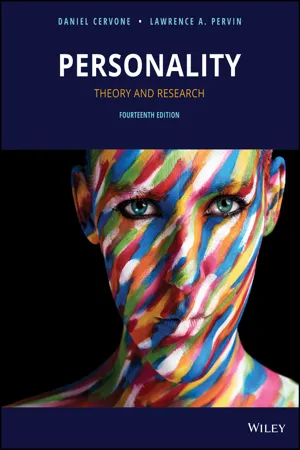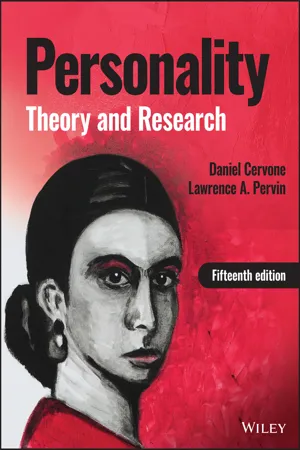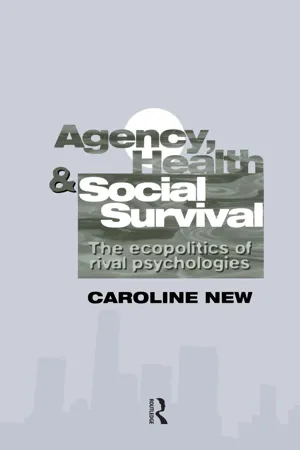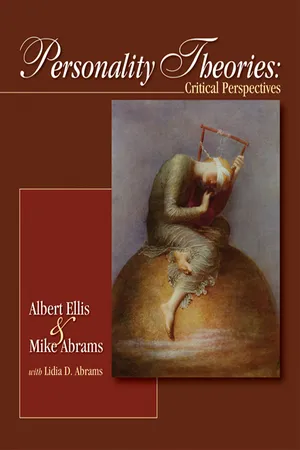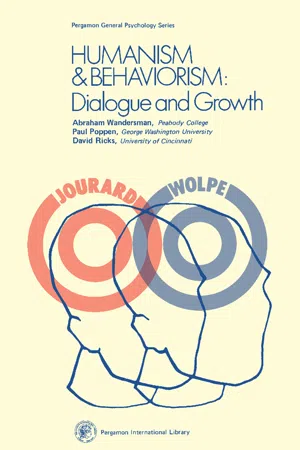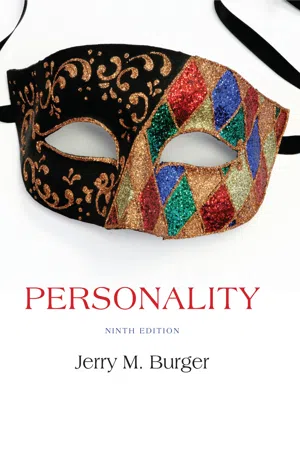Psychology
Humanistic Theory of Self
The Humanistic Theory of Self emphasizes the individual's capacity for personal growth, self-actualization, and fulfillment of potential. It focuses on the subjective experiences and perceptions of the self, emphasizing the importance of personal agency and self-awareness. This theory highlights the significance of human emotions, creativity, and the pursuit of meaning and purpose in life.
Written by Perlego with AI-assistance
Related key terms
1 of 5
9 Key excerpts on "Humanistic Theory of Self"
- eBook - PDF
- Richard Ryckman(Author)
- 2020(Publication Date)
- Cengage Learning EMEA(Publisher)
P A RT 5 Humanistic/Existential Perspectives The theories considered in this section of the text are part of the third-force move- ment in contemporary psychology. (The other two movements are psychoanalysis and behaviorism.) The term was coined by Abraham Maslow (Chapter 12) to describe a position that focuses on the creative potentialities inherent in human beings and that seeks ways to help them realize their highest and most important goals. Virtually all of the humanistic theories postulate the existence of an innate growth mechanism within individuals that will move them toward realization of their potentialities if environmental conditions are right. This growth process has been variously labeled by its numerous proponents as the drive toward self- actualization, self-realization, or selfhood. The roots of the humanistic movement can be found in the writings of Jung, Adler, Horney, Kohut, Allport, Maslow, Rogers, May, and others. These theorists all emphasize the uniqueness of individuals and believe that all individuals should be free to make their own choices about the direction they want to take in their own lives. People should be allowed to organize and control their own behavior; they should not be controlled by society. Society is generally seen as the “bad guy,” the enforcer of rules and regulations that stifle personal growth. According to the humanists, a benevolent, helpful attitude toward people allows them to grow and prosper. Most societies, they believe, attempt to coerce indivi- duals into behaving appropriately, that is, normally. The result is rather dull, conventional people who usually obey, without much question, the moral pre- scriptions of the majority. In other words, the result is the average, law-abiding man or woman. The humanistic psychologists argue, instead, for allowing individuals to develop to their fullest potential. They see people as naturally striving to be crea- tive and happy rather than mediocre and conventional. - eBook - PDF
Personality
Theory and Research
- Daniel Cervone, Lawrence A. Pervin(Authors)
- 2018(Publication Date)
- Wiley(Publisher)
As a theorist, his overarching goal was to develop a framework to explain the nature and development of the self as the core element of personality. Rogers’s phenomenological self-theory can also be described by another term: humanistic. Rogers’s work is part of a humanistic movement in psychology whose core feature was to emphasize people’s inherent potential for growth. This chapter, then, introduces you to the theory—the phenomenological, human- istic, self-theory—that is the enduring legacy of one of the great American psycholo- gists of the 20th century, Carl Rogers. A PHENOMENOLOGICAL THEORY 128 Questions to be Addressed in this Chapter 1. What is the self, and why might one not act in a manner consistent with one’s true self? 2. Freud viewed motivation in terms of tension reduction, the pursuit of pleasure, and intrapsy- chic conflict. Is it possible to view human motivation, instead, in terms of personal growth, self-actualization, and feelings of congruence? 3. How important is it for us to have a stable self-concept? How important is it for our internal feelings to match our self-concept? What do we do when feelings are in conflict with our self-beliefs? 4. What are the childhood conditions that produce a positive sense of self-worth? In the previous chapters, you learned about Freud’s psychoanalytic theory of personality and related psychodynamic positions. We now introduce a second, entirely different perspective. It is that of the American psychologist Carl Rogers. His work exemplifies a phenomenological approach to the study of persons. At the outset, you should consider how these conceptions, Freud’s and Rogers’s, are related. Rogers did not disagree with everything Freud said about persons. He recognized that Freud provided some insights about the workings of the mind that are of enduring value. Also, Rog- ers worked in a style that was similar in some ways to that of Freud. - eBook - PDF
Personality
Theory and Research
- Daniel Cervone, Lawrence A. Pervin(Authors)
- 2022(Publication Date)
- Wiley(Publisher)
As a theorist, his overarching goal was to develop a framework to explain the nature and development of the self as the core element of personality. 134 A PHENOMENOLOGICAL THEORY: THE PERSONALITY THEORY OF ROGERS Questions to Be Addressed in This Chapter 1. What is the self, and why might one not act in a manner consistent with one’s true self? 2. Freud viewed motivation in terms of tension reduction, the pursuit of pleasure, and intrapsy- chic conflict. Is it possible to view human motivation, instead, in terms of personal growth, self-actualization, and feelings of congruence? 3. How important is it for us to have a stable self-concept? How important is it for our internal feelings to match our self-concept? What do we do when feelings are in conflict with our self-beliefs? 4. What are the childhood conditions that produce a positive sense of self-worth? What do you think of yourself? Next question: What did you think of that question? It seemed straightforward, right? There’s this thing, your “self,” and you can contemplate it and answer the question, “what do you think of it.” You also can answer questions like these: “How are you doing these days?” “What do you think about your future?” In each case, it is clear what the question is about: the whole, coherent psychological entity that is you, yourself. Here’s the funny thing. You might expect that this whole, coherent psychological entity—your self—would be the centerpiece of every theory of personality. But it isn’t. In fact, it isn’t the cen- terpiece of any of the major theories of personality presented elsewhere in this book. Consider the others (all of which were overviewed in Chapter 1). In psychodynamic theory, the psychological core of personality is not a conscious self that you reflect upon. It’s a set of unconscious mecha- nisms that you cannot reflect upon. In behaviorism, any answer you give to the question “What do you think of yourself?” is, itself, merely a behavior. - eBook - ePub
Ordinary Ecstasy
The Dialectics of Humanistic Psychology
- John Rowan(Author)
- 2015(Publication Date)
- Routledge(Publisher)
But in fact the two things are like chalk and cheese. The main plank in humanistic psychology is the integration of body, feelings, intellect, soul and spirit, and it says so very clearly in all the introductory leaflets put out by AHP affiliates in various countries around the world. This integration is the key to what we call self-actualization, and all our workshops touch on it in some way. The secular humanists, on the other hand, are often not much interested in the body or in feelings, and actively deny any existence to the spiritual or transpersonal aspects of our life.I actually joined the British Humanist Association (BHA) at one time, to See whether any links could be made, but I found the people involved in it to be aridly intellectual, unawarely sexist and very narrow, spending a lot of their time and energy knocking Christianity, and some of the rest on issues like abortion and euthanasia. I lasted a year and walked out in protest at the sexism expressed at the Annual General Meeting.Now it may well be that secular humanism should not be judged by the activities of the BHA (or the National Secular Society, which it much resembles) because humanism is itself a much wider philosophy. Nevertheless, the BHA is trying to represent it, and there must be some connection somewhere. None of these things is humanistic psychology.Passage contains an image
2 Humanistic Psychology is and is Not Optimistic
When people first come across humanistic psychology, they usually find it presented as full of blue-sky optimism. This is because the presentation is restricted to Abraham Maslow and Carl Rogers. What I want to say here is that humanistic psychology is not restricted to these, but also includes people like James Bugental, Rollo May, Kirk Schneider and Alvin Mahrer who are not particularly optimistic at all.Maslow and Mahrer
Abraham Maslow is a very important pioneer figure in humanistic psychology. His theory of human needs and human development says that there is a normal process of growth which applies to all people (see Table 2.1 - eBook - ePub
Agency, Health And Social Survival
The Ecopolitics Of Rival Psychologies
- Caroline New(Author)
- 2015(Publication Date)
- Routledge(Publisher)
Chapter 7 Humanistic psychology: Saved by synergyIntroduction
We turn now to humanistic psychology, which embraces independence of social conventions as part of its notion of mental health. Humanistic psychology is as diverse as psychoanalysis. It is united only by the principle that the true, original self is naturally social and cooperative and that both inner conflict and social evil are environmentally produced. There is not such a gulf between psychoanalysis and humanistic psychology as my selection of theorists might suggest. Ego psychology's 'conflict-free zone' of the ego begins to bridge the gap. Horney, Fromm, Sullivan and the 'culture school' identify patterns of defence as typical of entire societies and as products of their culture (e.g. Sullivan, 1964, p. 70). Reich (1968) believes that genitally healthy people, capable of surrendering themselves in genuine orgasm, would be socially cooperative, non-authoritarian and self-regulating. The mismatch between society and our real, genital selves is merely 'the artifact of a sex-negating culture' (Reich, 1968, p. 232). And as we have seen, for object-relations theorists such as Fairbairn, Guntrip, Winnicott, Kohut and Kernberg the individual's internal world is significantly affected by the environment, as 'formed in the cataclysmic encounters of childhood and perpetuated in the depths of the unconscious' (Frosch, 1987, p. 94). Social relations are key to the construction of the self. Aggression tends to be reactive and the drives operate in the service of a relationship-seeking ego. If the social environment allows the child's needs to be met (including its need for love), theoretically internal splitting can be avoided.The theories so briefly mentioned here form a philosophical bridge between psychoanalytic and humanistic theories. For this very reason, the conflicting principles involved in this area are more clearly extracted from the theories on either side of the stream. From the psychoanalytic side, object-relations theories are frequently accused of having gone over to humanism, to the territory of the 'true self' and the 'whole ego' (Frosch, 1987, p. 107). We have seen how contemptuous Lacan was of ego-psychology, of its faith in the ego's susceptibility to reason. For him, too, American ego-psychology and humanistic psychology were both revisionist idiocies which elevated that illusion: the conscious self as rational actor. In order to assess these criticisms we must now cross the water to the territory of the 'human potential movement'. - eBook - PDF
- Jerry Burger(Author)
- 2018(Publication Date)
- Cengage Learning EMEA(Publisher)
Due to electronic rights, some third party content may be suppressed from the eBook and/or eChapter(s). Editorial review has deemed that any suppressed content does not materially affect the overall learning experience. Cengage Learning reserves the right to remove additional content at any time if subsequent rights restrictions require it. 272 Chapter 11 / The Humanistic Approach T: Logically, you realize that courage is one of your deficiencies, but inside yourself you find yourself laughing at that notion and feeling that it doesn’t really have anything to do with you. Is that it? C: That’s right. I always sort of make myself different. That’s it. (1947, pp. 138–140) Therapists never tell clients what the client really means to say. Instead, ther- apists restate what they believe they are hearing. However, these restatements are only suggestions for the client to agree with or reject. If the process is effective, cli- ents come to see themselves as others do and eventually accept or modify what they see. Clients may come to understand that they have been distorting or denying parts of their experiences. A man may realize he has been trying to live up to his father’s impossibly high expectations, or a woman may come to understand she is afraid to commit herself to a serious relationship. In the freedom provided by the therapist’s unconditional support, clients peel away their defenses, accept who they are, and begin to appreciate all of life’s experiences. Today a large number of psychotherapists identify their approach as humanistic (Cook, Biyanova, Elhai, Schnurr, & Coyne, 2010), and many others include aspects of person-centered therapy in their work (Cain & Seeman, 2002). - eBook - ePub
Personality Theories
Critical Perspectives
- Albert Ellis, Mike Abrams, Lidia Abrams(Authors)
- 2008(Publication Date)
- SAGE Publications, Inc(Publisher)
Chapter 11Humanistic Views of Personality
Chapter Goals- Outline the development of the humanistic school in psychology
- Show how humanism came into being, in part as a response to the pessimistic concepts of psychoanalysis and the mechanistic methods of behaviorism
- Explain the importance and role of Abraham Maslow in the humanistic movement in psychology
- Trace the growth of the existential movement in psychology and detail its connection to humanism
- Explore both the strengths and weaknesses of humanistic psychology in explaining human personality
T he fact that we speak at all of a humanistic approach to psychology leads to an obvious question: Why did some psychologists feel this approach was necessary? After all, to propose a humanistic approach to psychology implies that psychology in its essence is not concerned with human beings. In fact, this was precisely the point the early humanist psychologists were making.By the middle of the 20th century, psychiatry was dominated by psychoanalytic views of personality as well as of mental pathology. The leading school of thought in the field of psychology itself was behaviorism, which was taught and practiced in most universities and clinical centers, especially in the United States. A majority of psychologists approached all organisms, including humans, in terms of their responses to stimuli. Such internal events as thoughts and emotions were considered to be irrelevant to psychology. They could neither be observed nor directly tested; thus, including them in analyses of human nature was considered unscientific. This restriction led some psychologists to find the dominant view far too limiting. They maintained that behaviorism had eliminated some of the most important dimensions of the human psyche. This point of view had been indirectly supported in an earlier generation by such psychologists as Max Wertheimer, Kurt Koffka, and Wolfgang Köhler. These theorists are generally credited with developing the Gestalt (from the German word for form or shape - eBook - PDF
Humanism and Behaviorism
Dialogue and Growth
- Abraham Wandersman, Paul J. Poppen, David F. Ricks(Authors)
- 2016(Publication Date)
- Pergamon(Publisher)
The positive side of this ambivalence seems rooted in the subjective reality of the experienced self; beyond infancy, each person seems aware of himself, at least some of the time. Each mature individual discriminates between self and the rest of the world ; each has a sense of himself or herself as a distinct entity. In spite of the fact that every cell of the body changes in the course of life, this perceived identity, this self-consciousness, appears to be a basic human experience and its loss is interpreted as no less than a loss of reality itself. On the negative side, this ambivalence seems based on the reluctance to create a self as an extracausal agent that resides in the person and somehow is responsible for (generates, causes, regulates) behavior in ways that are separ-able from the organisms in which it dwells. Consider, for example, this excerpt from Carl Rogers: . . . when the self is free from any threat of attack 1 The writing of this paper was facilitated by research grant MH-6830 to Walter Mischel from the National Institute of Mental Health, United States Public Health Services. 145 146 Humanism and Behaviorism: Dialogue and Growth or likelihood of attack, then it is possible for the self to consider these hitherto rejected perceptions, to make new differentiations, and to reintegrate the self in such a way as to include them (Rogers, 1947, p. 365). For Rogers the self seems to be not a synonym for the me or I or ego ; it is a self apparently distinct from the total person and from what he or she does—indeed it is a self that even can reintegrate the self. Many psychologists (including Gordon Allport who, in 1937 and 1961, wrote so persuasively on this topic) are unwilling to give the self such extra-ordinary causal powers: To say that the self does this or that, wants this or that, wills this or that, is to beg a series of difficult questions. The psychologist does not like to pass the buck to a self-agent ... - eBook - PDF
- Jerry Burger, , , , Burger(Authors)
- 2014(Publication Date)
- Cengage Learning EMEA(Publisher)
Person-Centered Therapy Carl Rogers ’ approach to counseling presents an interesting challenge for humanistic psychotherapists. According to Rogers, a therapist cannot possibly understand clients as well as clients understand themselves. He also main-tained that clients, rather than the therapist, are responsible for changing themselves. So what is left for therapists to do with people who come to them for help? Rogers ’ answer was that a therapist ’ s job is not to change the client but to provide an atmosphere within which clients are able to help themselves. He called this approach person-centered therapy . Rogers believed each of us grows and develops in a positive, self-actualizing fashion unless our progress is in some way impeded. The therapist simply allows the client to get back on that positive growth track. After successful Rogerian therapy, clients should be more open to personal experience, more able to accept all aspects of themselves, and therefore less likely to use defenses when encountering information that threatens their self-concept. In short, they should be more fully functioning and happier people. But how is this accomplished? Therapists must first create the proper relationship with their clients. The most important rule here is to be open and genuine. Therapists should be themselves rather than play the role of therapist they were taught in graduate school. This means being honest with clients, even if that includes being very frank (but not cruel) at times. Rogers believed clients can always tell when a therapist isn ’ t being genuine with them, and the mistrust that comes from this perception can doom a therapeu-tic relationship. “ When I accept myself as I am, then I change. ” C ARL R OGERS 296 CHAPTER 11 • The Humanistic Approach Copyright 2015 Cengage Learning. All Rights Reserved. May not be copied, scanned, or duplicated, in whole or in part.
Index pages curate the most relevant extracts from our library of academic textbooks. They’ve been created using an in-house natural language model (NLM), each adding context and meaning to key research topics.

